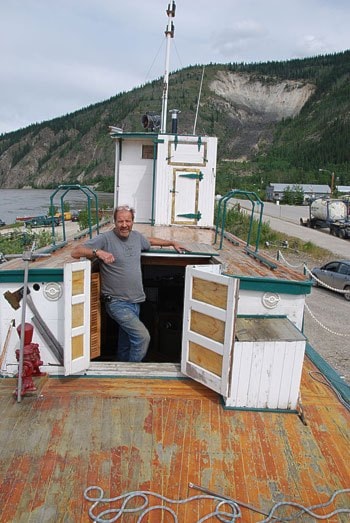In early days of the Yukon’s recorded history, the territory was isolated from the outside world.
The railroad and a coordinated network of sternwheel river boats eventually cut the summer travel to places like Vancouver and Seattle from months or weeks to a few days. Air travel reduced the travel time to a few hours, and the completion of a network of roads and highways have brought the Yukon within the reach of truckers, travelers and tourists, and reduced ordinary travel time and the cost of delivering goods substantially.
Three people who made contributions to that transition were inducted into the Yukon Transportation Hall of Fame on June 3. Due to renovations, the event, which is normally held in the Yukon Transportation Museum, was relocated to the nearby Beringia Centre for the occasion.
The first to be honoured was Welsh-born Andy Williams, the silver-haired master of the skies of the Kluane Icefields, who was inducted into the Order of Polaris. The award, presented by Commissioner Doug Phillips, honours a significant contribution or meritorious service “North of 60” in advanced northern aviation. For more than 40 years, Williams has served as one of the world’s premier glacier pilots.
Using a sprightly four-passenger Helio Courier airplane, Williams has mastered short take-offs and landings on uneven patches of ice and snow at elevations as high as 6,000 metres. Weather can change in a heartbeat and the winds blowing through the peaks can buffet an airplane and throw it around “like a ping pong ball.”
“I didn’t know enough about aircraft back then (when he started flying into the ice fields) to realize that landing at those high altitudes was a very silly thing to do,” said Williams.
Tom Mickey has been in the trucking business in the North for nearly 50 years. Originally from Rimbey, Alberta, he was hired to manage Gordie’s Trucking (later to become Yukon Freight Lines Limited) from 1966 to 1971. Tom went into business for himself in 1973 by purchasing Arctic Towing, adding a trucking arm to the business in 1974. In 1975, he sold the towing business and expanded his trucking service, now called Frontier Freight Lines, to include Ross River, Faro the Alaska Highway and Dawson City. Supplying the miners and the community surrounding Dawson City provided Frontier with a solid business footing.
Tom was also one of the founding members of the Yukon Transportation Association, which consisted of members representing the trucking, rail and air industries, and whose purpose was to lobby government for changes that would impact industry safety regulations. He received his award from Highways Minister Wade Istchenko.
Liard Tom was raised in a cabin about 30 kilometres upriver from the Upper Liard Bridge and as a child trapped with his father on the Rancheria River. He often travelled between their home on the Liard River and Atlin, British Columbia, and south into Dease Lake, all before the advent of highways. Because of his work associated with the Hudson’s Bay Company, he spoke English as well as his native Kaska language.
His knowledge of the land surrounding Watson Lake was invaluable to the U.S. Army Engineers, who were constructing the Alaska Highway during World War II. He flew with them to the Upper Rancheria River area and landed with government surveyors, where they met with surveyors and First Nation guides coming from Teslin in the opposite direction.
Liard Tom subsequently moved his family to Watson Lake to work on the construction of the Watson Lake Airport for the army. He worked with the army slashing and cutting trees beside the bulldozers that were leveling a runway for the new airport.
Liard Tom is therefore symbolic of the important role played by him and the many other First Nation people who contributed their knowledge and skills to the construction of the Alaska Highway. That route has since become the most important transportation artery between the Yukon and the rest of the world.
Liard Tom passed away in 1974. Receiving the award from Minister Istchenko was Tom’s daughter, Ms. Angela Carlick, who, along with son William Carlick, shared her memories of her father, and life in the early days, with the nearly 100 people who attended the ceremony.
Special note was also made by Tracy Bendera, acting director of transport services, of the late Venerable Archdeacon Ken Snider, who passed away recently. Snider served as a member of the award selection committee for the Transportation Hall of Fame for many years. Snider was the first Yukon representative on the historic sites and monuments board, acting as an observer at their meetings in the 1960s, and was involved in many activities related to Yukon history over the decades.
Plaques honouring the achievements of Andrew Williams, Tom Mickey, and Liard Tom will be installed along with those of all the others who have been recognized, in the Transportation Hall of Fame, located in the Yukon Transportation Museum near the airport. I encourage everyone to check it out when visiting the museum.
Michael Gates is a Yukon historian and sometimes adventurer based in Whitehorse. His latest book, Dalton’s Gold Rush Trail, is available in Yukon stores. You can contact him at msgates@northwestel.net
